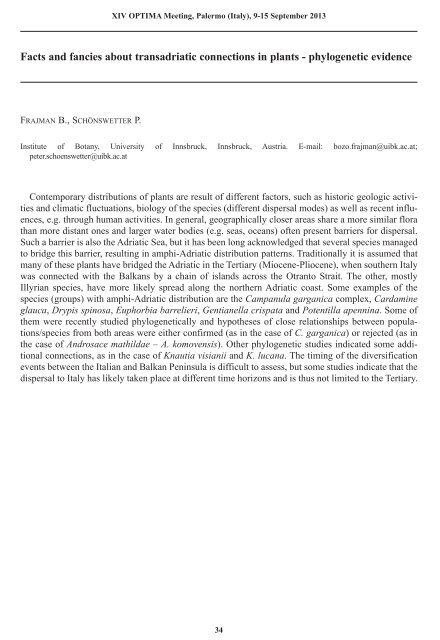Abstracts, XIV OPTIMA Meeting, Palermo (Italy) , 9-15
Abstracts, XIV OPTIMA Meeting, Palermo (Italy) , 9-15
Abstracts, XIV OPTIMA Meeting, Palermo (Italy) , 9-15
Create successful ePaper yourself
Turn your PDF publications into a flip-book with our unique Google optimized e-Paper software.
<strong>XIV</strong> <strong>OPTIMA</strong> <strong>Meeting</strong>, <strong>Palermo</strong> (<strong>Italy</strong>), 9-<strong>15</strong> September 2013<br />
Facts and fancies about transadriatic connections in plants - phylogenetic evidence<br />
FRAJMAN B., SCHÖNSWETTER P.<br />
Institute of Botany, University of Innsbruck, Innsbruck, Austria. E-mail: bozo.frajman@uibk.ac.at;<br />
peter.schoenswetter@uibk.ac.at<br />
Contemporary distributions of plants are result of different factors, such as historic geologic activities<br />
and climatic fluctuations, biology of the species (different dispersal modes) as well as recent influences,<br />
e.g. through human activities. In general, geographically closer areas share a more similar flora<br />
than more distant ones and larger water bodies (e.g. seas, oceans) often present barriers for dispersal.<br />
Such a barrier is also the Adriatic Sea, but it has been long acknowledged that several species managed<br />
to bridge this barrier, resulting in amphi-Adriatic distribution patterns. Traditionally it is assumed that<br />
many of these plants have bridged the Adriatic in the Tertiary (Miocene-Pliocene), when southern <strong>Italy</strong><br />
was connected with the Balkans by a chain of islands across the Otranto Strait. The other, mostly<br />
Illyrian species, have more likely spread along the northern Adriatic coast. Some examples of the<br />
species (groups) with amphi-Adriatic distribution are the Campanula garganica complex, Cardamine<br />
glauca, Drypis spinosa, Euphorbia barrelieri, Gentianella crispata and Potentilla apennina. Some of<br />
them were recently studied phylogenetically and hypotheses of close relationships between populations/species<br />
from both areas were either confirmed (as in the case of C. garganica) or rejected (as in<br />
the case of Androsace mathildae – A. komovensis). Other phylogenetic studies indicated some additional<br />
connections, as in the case of Knautia visianii and K. lucana. The timing of the diversification<br />
events between the Italian and Balkan Peninsula is difficult to assess, but some studies indicate that the<br />
dispersal to <strong>Italy</strong> has likely taken place at different time horizons and is thus not limited to the Tertiary.<br />
34






